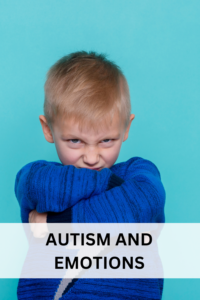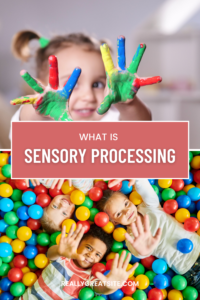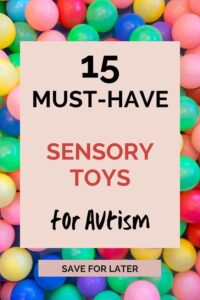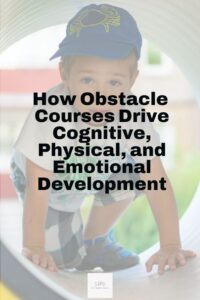
As parents of children with autism, you play a pivotal role in helping your child navigate autism and emotions.
Autism Spectrum Disorder (ASD) presents unique challenges when it comes to emotional regulation, but with understanding, patience, and the right strategies, you can support your child in managing their emotions effectively.
This comprehensive guide will delve deeper into the relationship between autism and emotions, the importance of emotional regulation, and provide detailed strategies to help your child thrive.

Hi! My name is Marra and I’m a mama and a pediatric occupational therapist who has years of experience working with children with autism and helping their parents navigate the ups and downs of child development.
I loved being a support person for parents learning about autism, sensory processing, and their child’s individual needs. A big part of that is helping them navigate autism and emotions for their child.
I would often recommend to families sensory and emotional regulation tips and strategies to help them manage challenging emotions.
This post is all about the relationship between autism and emotions. I will also provide you with strategies to help you navigate the ups and downs of emotional regulation.

Understanding the Connection Between Autism and Emotions
Autism Spectrum Disorder affects how individuals perceive and interact with the world. One significant aspect of this is emotional regulation.
Children with autism often experience emotions more intensely and may have difficulty expressing or understanding them in typical ways.
This can lead to challenges with emotional regulation, which is our emotional response to the sensory input that we receive from our environment.
If children with autism have difficulty with sensory processing, they may have more difficulty regulating their emotional response to that sensory input.

Emotional Sensitivity
Children with autism can be more sensitive to different sensory input. Sounds, lights, textures, and even certain smells can trigger strong emotional reactions because it may be hard for them to process these senses.
This heightened sensitivity can lead to sensory overload, where the child feels overwhelmed and unable to process their environment, resulting in emotional outbursts or withdrawal.
Challenges in Emotional Recognition
Recognizing and interpreting emotions—both their own and others’—can be difficult for children with autism.
They might struggle to read facial expressions, tone of voice, or body language, which can lead to misunderstandings and frustration. This difficulty in emotional recognition can affect their social interactions and relationships.
Expressing Emotions
Children with autism may express emotions in ways that are different from neurotypical children.
For example, they might have difficulty verbalizing their feelings and instead express them through behaviors such as stimming (repetitive movements or sounds), meltdowns, or withdrawal. Understanding these behaviors as expressions of emotion is crucial for parents.

The Importance of Emotional Regulation
The relationship between autism and emotions involve emotional regulation.
Emotional regulation is the ability to monitor, evaluate, and modify emotional reactions in different sensory situations. For children with autism, developing these skills is so helpful for several reasons:
Enhancing Social Interactions
Children with autism often find social interactions challenging. Emotional regulation helps them understand and respond to social cues more effectively.
This can improve their ability to form and maintain friendships, which is essential for their social development.
Reducing Behavioral Issues
Challenging behaviors such as aggression, self-injury, or severe tantrums are often linked to difficulties in emotional regulation.
By helping your child develop these skills, you can reduce the frequency and intensity of these behaviors, leading to a more harmonious home environment.
Promoting Mental Health
Children with autism are at a higher risk for anxiety, depression, and other mental health issues.
Effective emotional regulation can mitigate these risks by providing them with tools to manage stress and emotional overwhelm.
Improving Learning and Development
Emotional regulation skills are closely linked to cognitive functions such as attention, memory, and problem-solving.
Children who can manage their emotions are better equipped to focus and engage in educational activities, leading to improved academic performance and overall development.

Detailed Strategies for Managing Emotions in Children with Autism
As a parent, you can implement various strategies to help your child develop emotional regulation skills. These strategies can be tailored to fit your child’s unique needs and preferences.
Create a Safe and Predictable Environment
Consistency and routine provide a sense of security for children and can help them manage autism and emotions. A predictable environment helps reduce anxiety and emotional outbursts. Here are some tips to create a safe and predictable environment:
- Establish Routines: Create daily routines for activities such as waking up, meals, playtime, and bedtime. Visual schedules can help your child understand and anticipate what comes next.
- Prepare for Transitions Transitions between activities can be challenging. Prepare your child for transitions by giving advance warnings and using visual or auditory cues. For example, a timer can signal the end of an activity.
- Create a Calm-Down Space: Designate a specific area in your home where your child can go to calm down when feeling overwhelmed. This space should be quiet and filled with soothing objects or activities, such as soft pillows, calming music, or sensory toys.

Teach Emotional Recognition and Expression
You can help your child manage autism and emotions by helping them recognize and express their emotions is fundamental to emotional regulation. Here are some strategies to teach emotional recognition and expression:
- Use Visual Aids: Emotion cards, charts, and apps can help your child identify and label their feelings. These tools provide visual representations of different emotions and can be used in daily activities.
- Model Emotional Expression: Verbalize your own feelings in different situations. For example, say, “I feel happy because we are going to the park,” or “I feel frustrated when things don’t go as planned.” Modeling emotional expression helps your child understand and mimic these behaviors.
- Encourage Alternative Communication: If your child has difficulty verbalizing emotions, encourage them to use pictures, gestures, or assistive communication devices to express their feelings. For example, they can point to a picture of a sad face when they feel upset.
Develop Coping Skills
Teaching your child coping skills is essential for managing autism and emotions. These skills can help your child calm down and regain control when feeling overwhelmed. Here are some effective coping strategies:
- Deep Breathing: Teach your child to take slow, deep breaths to calm their body and mind. Practice this technique regularly so they can use it during stressful moments.
- Counting: Encourage your child to count to ten or twenty when they feel upset. This simple activity can help them pause and regain control.
- Use a Weighted Blanket: Weighted blankets provide deep pressure stimulation, which can have a calming effect. Allow your child to use a weighted blanket during times of stress or before bedtime to promote relaxation.

Implement Sensory Integration Activities
Sensory integration activities can help regulate autism and emotions by addressing sensory sensitivities. Here are some activities that may be beneficial:
- Sensory Bins: Create sensory bins filled with materials such as rice, sand, or water beads. Encourage your child to explore these textures, which can provide sensory stimulation and promote relaxation.
- Fidget Toys: Fidget toys such as stress balls, fidget spinners, or textured objects can help your child manage sensory input and stay calm.
- Deep Pressure Activities: Activities that provide deep pressure, such as bear hugs, using a therapy ball, or pressing against a wall, can help regulate sensory input and emotions.
Use Social Stories
Social stories are short, descriptive stories that explain social situations and appropriate responses. They can be a valuable tool for helping children with autism understand and manage emotions. Here’s how to create and use social stories:
- Identify Challenging Situations: Identify specific situations where your child struggles with emotional regulation, such as transitioning to a new activity or handling disappointment.
- Create Personalized Stories: Write short stories that describe these situations and appropriate emotional responses. Use simple language and include pictures or illustrations to enhance understanding.
- Practice Regularly: Read social stories with your child regularly, especially before encountering challenging situations. This practice can help them internalize and apply the strategies in real-life scenarios.
Encourage Physical Activity
Physical activity is a powerful tool for managing emotions. It helps reduce stress, improve mood, and increase overall well-being. Here are some ways to incorporate physical activity into your child’s routine:
- Daily Exercise: Ensure your child gets regular physical exercise. Activities such as swimming, dancing, jumping on a trampoline, or playing in a park can be enjoyable and beneficial.
- Movement Breaks: Incorporate movement breaks throughout the day, especially during activities that require prolonged focus, such as schoolwork. Simple activities like stretching, jumping jacks, or a short walk can help release excess energy and improve concentration.

Professional support can provide additional resources and guidance for managing emotions. Here are some professionals who can help:
- Occupational Therapists: Occupational therapists can assess your child’s sensory processing and emotional needs and provide tailored interventions. They can teach coping strategies, recommend sensory integration activities, and create personalized plans for emotional regulation.
- Psychologists: Psychologists can provide therapy to address emotional and behavioral challenges. Cognitive-behavioral therapy (CBT) and other therapeutic approaches can help your child develop emotional regulation skills.
- Social Skills Groups: Enrolling your child in social skills groups can provide opportunities to practice emotional regulation in a supportive environment. These groups often include structured activities and peer interactions.
Managing autism and emotions is a critical component of supporting children.. By understanding the unique ways in which autism affects emotional regulation and implementing tailored strategies, you can create a nurturing environment where your child can thrive.
Remember, each child is unique, so it’s essential to be patient and flexible in your approach.
As parents, you have the power to make a significant difference in your child’s emotional well-being.
By providing consistency, teaching emotional recognition, developing coping skills, incorporating sensory activities, using social stories, encouraging physical activity, and seeking professional support, you can help your child navigate their emotional world more effectively.
Feel free to share your experiences, ask questions, or suggest topics for future posts. Together, we can support each other in creating a positive and empowering environment for our children with autism.
